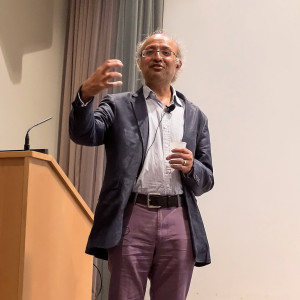January 13, 2014
The Adventures of Curiosity in Gale Crater, Mars
Professor Sanjeev Gupta
Report by: Chris Sutcliffe
Professor Sanjeev Gupta is one of the leading academics directing the Mars Curiosity mission, where his role is to analyse ancient sedimentary rocks on Mars and determine if the Red Planet could ever have been habitable for life. He is a geologist in the Department of Earth Science and Engineering at Imperial College, and has spent much of his career studying ancient sedimentary rock formations in places like the Sinai Peninsula, Egypt and New Mexico. He analyses sedimentary rocks to reconstruct ancient landscapes and past environmental conditions.
Sanjeev introduced the lecture by saying that he was a field geologist working in desert regions at a time when some of his colleagues were moving into more interesting roles. He came across some papers on the geology of Mars, which sounded fascinating and decided to move into this field.
The spacecraft Curiosity was launched in November 2011, which Sanjeev was privileged to see; 400 scientists and 200 engineers are involved with the project. Curiosity (the Mars Rover) has been working on Mars since August 2012 after an extraordinary landing sequence that has been dubbed the “7 minutes of terror”.
The Gale crater on the Martian equator was formed around 3.8 billion years ago. Its centre is a mountain of stratified rocks, rising 5km from the crater floor, and the crater is 150 km across.
Curiosity has 17 cameras on board. It also has an X-ray spectrometer, as well as drilling equipment and a laser that can pulverise rock from 7 metres away allowing spectral analysis of the rocks and soil.
For landing on Gale crater, the engineers’ priority was to preserve the instrumentation and, with this in mind, a good flat area between mountains was selected and Curiosity landed within 100 metres of where predicted. The navigation cameras help to support ground navigation – there is no ground map of Mars for them to follow! The hand-lens imager allows for microscopic images of the rock and soil to be taken.
The Martian day is 40 minutes longer than a day on Earth, meaning that the team had to work on a different time cycle each day. This clearly plays havoc with family life and team members only work this shift pattern for a few weeks at a time. When data comes available from Curiosity, the scientists only have a few hours to look at the data and produce a plan for the Rover’s next expedition. Sanjeev works between the engineers and scientists working out the plan for the next few days. Team members are spread all around the world and Sanjeev does some of his work from his house in Lewisham!
Gravelly mudstone or conglomerates were discovered which are probably streambed deposits. The streambed is ancient and likely originated from the northern crater rim.
The SAM (Sample Analysis at Mars) instrument found organic compounds and evidence of water, and Curiosity discovered fine-grained sedimentary rocks with diverse rock types with fractures and veins.
In determining which rocks do we look for, they were looking for evidence of stratification, but there are so many different types of rock. Well-cemented sandstone rocks were found with fine grains and cracks filled with gypsum. The sandstone is extremely hard, meaning that Curiosity’s wheels are taking a real pounding. This cementation is key evidence that a lot of water has flowed through these rocks in the past.
They obtained a first ever in-site dating of rocks on Mars, at the Cumberland drill site. The sediment is around 4.2 billion years old. This was as expected. More exciting though was the surface exposure dating, looked at how long parts of the surface had been exposed to cosmic rays. Parts of the surface have only been exposed for around 70 million years, which means that complex organic compounds may have been preserved.
In order to get access to Mount Sharp, the rover has to take a circuitous route to avoid driving through large sand dunes. The further up the mountain, the younger the terrain, as it is built up from sedimentary layers over billions of years. Somewhere within these layers, it may be possible to determine when the climate changed on Mars, allowing us to reconstruct how the surface of Mars has changed.
Sanjeev’s enthusiasm for the project was clearly evident in this fascinating lecture.
Further reading:
Here is a link to some recent major Curioisity papers:
http://mars.jpl.nasa.gov/msl/mission/science/researchpapers/
This is a great blog by mission chief scientist John Grotzinger:
Here are a couple of links of apps for MSL image data:
http://www.midnightplanets.com/index.html
Pictures from the Evening (by Mike Meynell and Mike Dryland):
Posted under: Flamsteed, Flamsteed Lecture, Meeting Report










You must be logged in to post a comment.